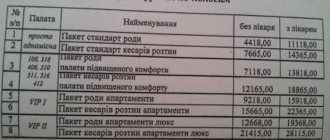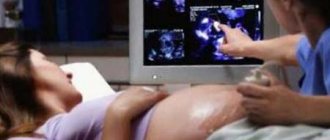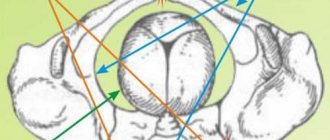Most often, if the first birth was carried out by cesarean section, then the second birth is carried out in the same way. Therefore, all women who have undergone a cesarean section during their first birth are advised, just in case, to be prepared for a second operation during childbirth. And here the question arises: at what time is a planned caesarean section performed during the second birth?
What are the disadvantages of a planned repeat cesarean?
The risks associated with a cesarean section, which include quite serious complications, become higher with each operation performed. These include:
- Adhesions are bands of scar tissue that appear during recovery from surgery. They can hold the pelvic organs together or attach them from the inside to the muscles of the abdominal wall. This can cause pain. Adhesions occur in half of women who have had a caesarean section. The probability increases to 75% if there were two cesareans and to 83% after three.
- Scar tissue forms after every surgery. If there is a lot of it, it will be difficult for the obstetrician to make another cut in your uterus, so the operation may take longer. In rare cases, the surgeon may accidentally cut into the bladder or bowel (NCCWCH 2011, RCOG 2008)
- during future pregnancies. This complication occurs when the placenta partially or completely covers the cervix. As a result, another caesarean section is required. The risk of this complication increases with each operation performed.
- Placenta accreta is a complication in which the placenta grows too deeply and does not detach from the wall of the uterus to be released after the baby is born. Removing the placenta in this case causes severe bleeding. Due to the potential threat to the life of mother and child, this condition requires urgent treatment, possibly surgery. In some cases, surgery to remove the uterus (hysterectomy) is necessary. The risk of placenta accreta, which may require a blood transfusion or hysterectomy, increases with each C-section. However, placenta accreta is rarely found in women who have undergone less than three operations.
- Babies born via Caesarean section often have breathing problems, especially if the operation was performed before 39 weeks. The baby may need medical attention (RCOG 2008). And this is more likely with a repeat cesarean than with a natural birth after a cesarean.
Possible consequences
Possible complications for the mother
After a second cesarean section, a woman may have:
- menstrual irregularities;
- various types of inflammation and other complications in the scar area;
- damage to tissues and internal organs - gastrointestinal tract, bladder, ureters;
- loss of ability to become pregnant again;
- thrombophlebitis (pelvic veins), anemia, endometritis;
- severe bleeding in the uterus, which may require removal of the entire uterus;
- high risk of complications in subsequent pregnancies.
For a newborn
The child may have a cerebrovascular accident or hypoxia due to prolonged exposure to anesthesia.
What are the benefits of a planned repeat cesarean?
Planned repeat caesarean section significantly reduces the risk (Guise et al 2010, RCOG 2008) of life-threatening complications for the baby. This is very rare during planned repeat cesarean sections. However, this is an uncommon occurrence during natural childbirth after cesarean section.
Complications in late pregnancy can in some cases lead to. The likelihood of a stillbirth is very low, but a timely planned repeat caesarean section can further reduce it.
After a planned cesarean section, newborns are less likely to require mechanical ventilation than in the case of a vaginal birth after a cesarean section. In addition, during a cesarean section, a woman does not have to endure the pain of contractions, as during natural childbirth. However, after the operation a painful stitch remains, and my stomach hurts for some time.
If we talk directly about childbirth and the first time after, then a repeat cesarean section allows you to avoid the following troubles:
- Pain in the abdominal muscles and discomfort due to hematomas and sutures in the perineal area.
- Heavy bleeding after childbirth.
- Incontinence when you cough or laugh. (NCCWCH 2011)
In the long term, another caesarean section may reduce the small but very real risk of uterine prolapse. However, this depends on many factors:
Pregnancy can weaken the pelvic floor muscles (NCCWCH 2012) and lead to nervous incontinence. Therefore, in any case, it is important to do exercises for the pelvic floor muscles, no matter how you plan to give birth.
If you are having a planned repeat cesarean section, then you know your baby's birthday in advance. It will be easier for you to prepare for the arrival of your baby and organize everything, especially if you need someone to help you in your absence. In addition, it will be easier for you and your husband to plan maternity leave and parental leave.
Possible complications
With repeated surgery, the risk of complications certainly increases. But this does not mean that they will definitely arise. If you give birth on your own after a cesarean section, then there is a possibility of scar dehiscence. Even if the suture is strong, doctors cannot completely exclude this possibility. That is why in such cases artificial stimulation and painkillers are never used. This is important to know.
When performing a second cesarean section, the doctor faces difficulties. The first operation always has consequences in the form of an adhesive process. Thin films between organs make the surgeon's work difficult. The procedure itself takes longer. This could be dangerous for the child. Indeed, at this moment, potent drugs used for anesthesia penetrate into his body.
A complication of a repeat cesarean can be the same as the first time: poor contraction of the uterus, its inflection, inflammation, and so on.
What if labor starts before cesarean?
If a caesarean section is scheduled for a specific day - for example, a week before the baby's birth date - labor may begin before then. This happens to one woman out of ten. If it is confirmed that this is indeed labor, an emergency caesarean section is usually performed.
If labor has already entered the active stage or your pregnancy is short (less than 37 weeks), you may be recommended to have a vaginal birth. Doctors will discuss your options with you so you understand what is happening to you and your baby.
Time of surgery
The average period of preliminary labor is calculated by the doctor. The preliminary date of natural birth is set at the end of the 38th week of pregnancy. The normal period can vary from 38 to 40 weeks. In case of caesarean section, the PDR time should be taken into account. It indicates the approximate time of onset of natural labor. To prevent this, surgery is scheduled for the end of the 38th week.
Many mothers ask at what time a second caesarean section is performed. Secondary intervention is also carried out at the end of the 38th week. If there are additional indications for surgery or the pregnancy occurred less than three years after the last pregnancy, the section is performed from the 36th week.
Sometimes dangerous situations arise with a woman’s general condition. In this case, the secondary intervention is carried out at a time that allows saving the life of the mother and child.
Is it possible to undergo sterilization during a planned caesarean section?
Before you decide to sterilize
, you need to think about everything very carefully. This is a very big step. First of all, it is worth knowing about all the risks. You will need to consult with a specialist who can help you make the right decision. You need to inform about your intention at least a week before the caesarean section.
There are good reasons not to rush into sterilization, but to postpone it for a while and think it over carefully. You need to make sure that this is really what you want. In addition, the procedure is somewhat more effective if it is performed after childbirth.
A second pregnancy that ends with a second cesarean section does not always go well. In some women, the scar from a previous operation becomes very thin, as a result of which many are admitted to the maternity hospital 2-3 weeks earlier than the expected date of birth. At what time is the second caesarean section performed and what difficulties await the woman?
Much depends on how the pregnancy went and for what reasons the first operation was performed. For example, if a woman has severe myopia or has fundus disorders, then there are indications for a repeat cesarean section. And doctors will not allow a woman to give birth on her own. And if the first operation was performed due to a long anhydrous interval, then a natural birth is quite possible. But only if the condition of the uterine scar at the time of birth is good and there are no other reasons for surgical delivery.
How is the second caesarean section performed, are there any special features? Almost none. At least for a woman. Although difficulties may arise if, for example, spinal anesthesia was used for the first time, after which women quickly recover. And the second time, general anesthesia was given for some reason. After general anesthesia, the recovery period is slightly longer.
Problems can also arise if a long period of time has passed between operations. That is, the woman is already over 30-35 years old. In this case, due to age, the risk of complications is higher. For example, there may be uterine fibroids, due to which the contractility of the myometrium is reduced and subinvolution of the uterus is likely, followed by an inflammatory process - endometritis. Many women have problems with their veins as they age. And this is a threat of thrombosis. For this reason, doctors recommend not removing compression stockings (bandages, stockings or socks) after surgery and wearing them for a few more days. And if there is pain in your leg, it turns red, or swells, immediately inform your doctor about it.
The good news is that the second cesarean section is performed using the same suture, which means that the woman will not have unnecessary cosmetic defects on the abdominal wall. As long as the suture material is of high quality, and the surgeon carefully stitches everything up. A lot depends on the doctor and his experience. Then the suture after the second caesarean section takes no longer to heal than after the first. Wound care is important. In the maternity hospital, this is done by the medical staff. Treats with antiseptics and makes dressings. And at home everything is in the hands of women. How long it takes for a caesarean section to heal for the second time will depend on how accurately you follow your doctor's recommendations. Doctors often do not advise treating the seam in any way at home. Just don't lift heavy things. And wash the seam itself with soap, but do not rub it with a washcloth. Within a few months, all discomfort in the suture area should disappear.
When will a woman be operated on again? It all depends on the indications for which the operation is performed. If there is nothing urgent, such as very high blood pressure, which cannot be brought down with medication, then the second planned caesarean section is performed at 39-40 weeks, that is, as close as possible to the expected date of birth, calculated by the doctor based on the results of an ultrasound in the early stages and date of the first day of the last menstruation. If a woman’s pregnancy after a second cesarean section proceeds with the threat of premature termination, and contractions begin, for example, at 35 weeks, then doctors try to help the woman carry the pregnancy to at least another 37-38 weeks, while at the same time giving injections to quickly ripen the fetal lungs. But if the amniotic fluid has broken or the condition of the fetus is poor, severe bleeding has begun - the operation is performed as soon as possible.
What is important to know about a second cesarean section to make it easier to survive? There are quite a lot of nuances. But those who have undergone this operation advise the main thing - to try to get up and move faster. This will help you recover faster. And if possible, do not get too carried away with painkillers.
And, of course, remember that this method of childbirth in no way detracts from your feminine qualities and does not indicate your inferiority. You were able to bear a child. And the method of delivery is not so important. The main thing is that doctors act in your interests and the interests of the child.
Don't rush to check out. Be sure to do an ultrasound before discharge. If doctors see signs of inflammation and lochia accumulation, they may suggest further treatment to avoid further problems with reproductive health.
Often during childbirth, circumstances can go wrong. Sometimes the baby cannot be born naturally. In this case, medical intervention in the laws of nature is necessary. They do everything necessary to save the child's life. Often it is necessary to resort to surgical intervention. In this article we will talk about how long a second planned caesarean section is performed, as well as what happens after childbirth.
Of course, the consequences of such an intervention are not the best. Often the doctor is forced to resort to a second caesarean section to prevent the risk of rupture of the sutures located in the uterine area. But, despite the myths, such an operation is not recommended for many women.
Pregnancy management
If the first birth took place via cesarean section, then the second time everything can be exactly the same or completely different. Expectant mothers after such a procedure should have an individual approach. As soon as you find out about your new situation, you need to contact a gynecologist. A special feature of managing such a pregnancy is additional research. For example, in such cases, ultrasound is done not three times during the entire period, but more. Diagnosis before childbirth is becoming more frequent. The doctor needs to monitor the condition of your uterine scar. After all, the entire outcome of pregnancy depends on this indicator.
Be sure to visit other specialists before delivery. You need to see a therapist, ophthalmologist, cardiologist, neurologist. Make sure there are no restrictions on natural childbirth.
In what cases is a second caesarean section inevitable?
Doctors prescribe a second cesarean section for a pregnant woman only after analyzing the various factors that accompany the entire pregnancy. In such a case, everything is important. After all, mistakes are not allowed so as not to harm the child’s life. Among the most common indications for such a procedure are the following cases.
- Cancer diseases.
- Myopia or farsightedness.
- High blood pressure or asthma.
- If the woman is over thirty years old.
- Diseases of the nervous system.
- When a woman has a narrow pelvis.
- If the woman had an abortion after a previous caesarean section.
- When there is connective tissue in the scar area.
- If there is a threat of divergence of existing seams.
- When, during the first caesarean section, the expectant mother was given longitudinal sutures.
- When postterm.
- With multiple births.
- When the fetus is too large or incorrectly presented.
- With weak labor activity.
- When less than two years have passed since the first operation was performed.
When even one of the above factors occurs, it is necessary to perform a cesarean section a second time. In other cases, the doctor will allow the expectant mother to give birth naturally. Most of the indications for repeating such an operation are already known. So, the young mother already knows that she will have to do a similar operation again. In such a situation, prepare for an important moment. In this way, possible risks can be prevented or reduced.
Is it possible to give birth on your own?
So, you are recommended for a second cesarean section. What is important to know about him? What are the real indications for surgery if the woman’s health is fine? Repeated manipulation is recommended in the following cases:
- the child has ;
- less than two years have passed since the first caesarean section;
- the suture on the uterus is incompetent;
- During the first operation, a longitudinal incision was made;
- abortions between pregnancies;
- the presence of connective tissue in the scar area;
- location of the placenta on the scar;
- pregnancy pathologies (polyhydramnios, oligohydramnios).
An emergency operation is performed in case of unexpected scar divergence, weak labor, a woman’s serious condition, and so on.
You can give birth yourself if a second caesarean section is recommended. What is important to know? Modern medicine not only allows a woman the natural process of childbirth, but also welcomes it. It is important that the expectant mother is thoroughly examined. The conditions for natural childbirth after cesarean section are the following circumstances:
- More than three years have passed since the first operation;
- the scar is wealthy (muscle tissue predominates, the area stretches and contracts);
- thickness in the seam area is more than 2 mm;
- no complications during pregnancy;
- a woman's desire to give birth on her own.
If you want your second child to appear naturally, then you should take care of this in advance. Find a maternity hospital that specializes in this issue. Discuss your condition with your doctor in advance and get examined. Attend your appointments regularly and follow your gynecologist's recommendations.
How to prepare for surgery?
Some helpful tips for preparing for your second elective caesarean section
If a doctor has prescribed a woman a repeat cesarean section, she should know how to prepare for such an operation. This way she can calm herself down and prepare herself for a successful operation. And it will be much easier for a woman to put her body in order.
Such preparation is important, because in most cases, if a pregnant woman is not serious about repeat surgery, not the best consequences are possible. So, if the expectant mother finds out that she needs to have a repeat cesarean section, she should take the following measures.
- During pregnancy, it is mandatory to attend prenatal courses that teach about caesarean section. You should also prepare for the fact that you will have to spend a lot of time in the hospital. We need to think about who will look after the older children, the house and pets.
- Be prepared for the fact that you will have to agree to a partner birth.
If a pregnant woman is given anesthesia after a repeat cesarean section and does not want to sleep, she will probably be more comfortable if her husband is nearby. - Also, do not forget about regular examinations prescribed by the gynecologist. Be sure to ask your doctor all your questions.
So, don’t be embarrassed to ask about how long such a procedure is prescribed and what medications the doctor gives. - When an expectant mother undergoes a repeat cesarean section, she often loses a lot of blood.
The reason for this is severe preeclampsia, incorrect position of the placenta. In such a situation, a donor will be needed. Close relatives are suitable for this role. This statement especially applies to owners of a rare blood group.
The seam
You already know at what time a planned second caesarean section is performed. The cesarean section is repeated using the same suture as the first time. Many expectant mothers are very concerned about aesthetic issues. They worry that their entire stomach will be covered in scars. Don't worry, that won't happen. If the manipulation is planned, then the doctor will make an incision where it was made the first time. Your number of external scars will not increase.
The situation is different with the incision of the reproductive organ. Here, with each repeat operation, a new area for the scar is selected. Therefore, doctors do not recommend giving birth using this method more than three times. For many patients, doctors offer sterilization if a second cesarean section is scheduled. When admitted to the hospital, gynecologists clarify this issue. If the patient wishes, tubal ligation is performed. Don’t worry, doctors will not carry out such a manipulation without your consent.
Characteristics of surgical intervention
The section is carried out using two methods. The operation depends on the location of the incision. The following types of sections are distinguished:
- horizontal;
- vertical.
Horizontal section is the most common form of surgery. During the operation, the suprapubic area is dissected. In this area there is a fetal convergence of the muscular, epidermal and uterine layers. This incision allows you to avoid various forms of postoperative complications.
Vertical intervention is carried out for medical reasons. The incision is made from the bottom of the pubic bone to the top of the diaphragmatic muscles. With this type of operation, the doctor has access to the entire abdominal cavity. Healing of such an incision is more problematic.
Women who have undergone the procedure are interested in how a second cesarean section is performed. In this case, the incision is made above the area of the previous scar. This will avoid causing additional injury to the uterine wall and will preserve the appearance of the abdominal area.
Before the operation begins, preparatory measures are carried out. The woman must go to the hospital 2 days before the scheduled procedure. During this time, a complete examination of the condition of the patient and the doctor is carried out. To examine the patient, a blood and urine sample is taken. If there is a suspicion of a bacterial infection, it is necessary to take a smear of vaginal microflora. A day before the intervention, a special diet is prescribed, which allows the intestines to cleanse themselves. On this day, a cardiotographic examination of the fetus is performed. The device allows you to set the number of heartbeats of the child. 8 hours before surgery, the woman is prohibited from eating. You should stop drinking 2 hours before.
The operation is simple. The average duration of surgery is 20 minutes. The time depends on the nature of the anesthesia. With complete anesthesia, the woman falls into a state of sleep. The doctor puts his hand into the incision and pulls the child out by the head. After this, the umbilical cord is cut. The child is handed over to the obstetricians. They assess the condition of the fetus on a ten-point scale. At this time, the doctor removes the placenta and the remains of the umbilical cord. The stitches are applied in reverse order.
If the second cesarean birth is scheduled for the first time, then incomplete anesthesia can be performed. In this case, the woman can see the child, but no pain is felt.
Possible complications
A variety of complications can occur after a caesarean section. They often occur during repeated intervention. The following types of probable pathologies are identified:
- development of the inflammatory process;
- bleeding;
- endometrial lesion;
- the appearance of adhesive tissue.
The development of the inflammatory process is observed against the background of fluid accumulation in the uterine cavity. Inflammation of the postoperative suture may also occur. A common problem is bleeding. Blood loss occurs against the background of severe inflammation. If it is not stopped promptly, the risk of death increases.
Sometimes another problem arises. It accompanies the vertical seam. In this case, the incision is made between the diaphragmatic muscles. During the recovery period, prolapse of the rectum into the hernial orifice may occur. In this case, the hernia develops rapidly.
Postoperative recovery
A second cesarean section requires a longer recovery period, which is important for patients to know. With the first surgical intervention, recovery occurs within one and a half months. The second intervention disables the body for two months.
Particular attention is paid to health in the first week after childbirth. The first day a woman should not eat food. It is allowed to drink water without gas. From the second day you can eat liquid food and unsalted rye crackers. Nutrition must be treated with special attention. If food is not selected correctly, constipation may occur. It is undesirable in the first month after surgery. You should also avoid carrying heavy objects. For the first week, the patient should not carry the baby in her arms. Wearing weights is allowed on the 8th day after the sutures are removed.
Childbirth is a natural physiological process. But they are not always possible. If a doctor prescribes surgery, he has a reason for it. Therefore, one should not refuse to perform repeated surgery. It will help maintain the health of mother and child.
It is not always recommended for a woman to give birth on her own. If there are a number of complications or characteristics of the body, childbirth is carried out using a planned caesarean section. This method involves bringing the baby into the world through an incision in the peritoneum and uterus. This surgical intervention is used in almost a third of births carried out in the country. Some of them are carried out not because of the doctor’s testimony, but because of the reluctance of mothers to endure pain during labor.
Indications for surgical intervention are divided into primary and secondary. The first are associated with physiological reasons. In this case, the need for a cesarean section is not even discussed. If there are secondary reasons, the doctor decides whether surgery should be performed or whether the birth can take place naturally. However, when giving birth to a baby on your own, there is a high risk of complications.
Main indications:
| Indication | Description |
| Feature of the anatomical structure | Narrow pelvis. Even before the onset of labor, the gynecologist examines the woman for the width of her pelvis. There are 4 degrees of its narrowness. If the fourth or third degree is detected, a planned cesarean section is performed; in the second, the need for surgical intervention is determined directly during childbirth. The first degree indicates the normal width of the pelvis, and the ability to produce a child independently |
| Presence of mechanical obstacles | A tumor or deformed pelvic bones can block the birth canal and prevent the baby from passing through during labor. |
| Possibility of uterine rupture | This threat is typical for women who give birth repeatedly, if the previous birth was also carried out through a caesarean section. The scars and sutures left on the uterus after this or any other abdominal surgery may come apart during muscle contractions during contractions. If there is such a risk, independent birth of a child is prohibited. |
| Premature placental abruption | The placenta is a unique environment necessary to provide the fetus with oxygen and nutrients. Its premature detachment leads to a threat to the baby’s life. Therefore, without waiting until the due date approaches, doctors immediately remove the child by caesarean section. If the fetus is not developed enough, it is connected to a system of artificial ventilation and nutrition. Placental abruption is determined using ultrasound. Heavy bleeding is also the main symptom of this pathology. A planned caesarean section is immediately scheduled. Most often, such births occur at 33-34 weeks of pregnancy. |
Secondary indications:
| Indication | Description |
| Chronic diseases | If you have chronic diseases, such as the eyes, cardiovascular or nervous system, during labor there is a high risk of exacerbation and severe harm to your own body. If a woman has diseases of the genital tract, such as genital herpes, then a cesarean section is mandatory so that the disease is not passed on to the baby |
| Weakness of labor | It often happens that the fetus in later stages begins to develop too slowly, and medications do not help. In this case, a decision is made to remove the fetus prematurely and connect it to oxygen and nutrient supply systems before full maturation. |
| Complications of pregnancy | Various pregnancy complications can pose a threat to the baby's life |
Types of caesarean section
There are two types of caesarean section: emergency and planned.
| Emergency | Planned |
| It is carried out if unexpected complications arise during childbirth. To save the lives of both the baby and his mother, a decision is made to immediately carry out surgical intervention. The health of the newborn depends on the qualifications of the doctor and the timeliness of his decision. | A planned caesarean section is prescribed by the surgeon as a result of monitoring the pregnancy of women. If indications for preventing natural childbirth are found, a date for the operation is set. Most often, it is as close as possible to the time when the baby should have been born independently. But a number of factors can affect delivery much earlier |
Timing of planned caesarean section
If there is no urgent need for surgery and the fetus is in normal condition, the first planned caesarean section is usually performed at 39-40 weeks. By this time, the child has already become fully formed and is able to breathe independently.
A repeat cesarean section is scheduled a couple of weeks earlier than this date. It is usually performed at 38 weeks of pregnancy.
But there are often cases when, as a result of emergency events, for example, premature placental abruption, the doctor decides to perform the operation much earlier than the due date. This can also happen if there is a sharp deterioration in the condition of the mother and her fetus. A caesarean section can be performed at 37 or even 35 weeks. The fetus is not yet full term, and the lungs may also not be developed. A neonatologist examines the baby after birth, identifies problems with breathing and pathologies, if any, and makes a decision on further actions with the baby. If necessary, the child is connected to a mechanical ventilation system and power supply through a feeding tube.
The duration of the operation is determined approximately by the surgeon. A week before giving birth, the expectant mother is hospitalized and undergoes all the necessary examinations. And only after receiving their data, the doctor sets a specific date and time.










